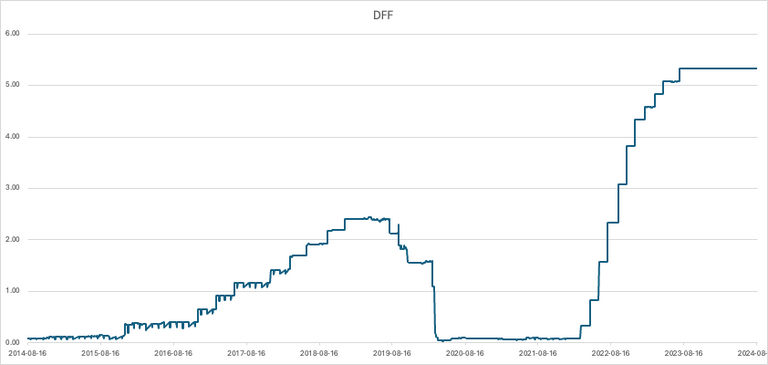Interest rates are a critical tool used by central banks to manage economic growth, control inflation, and influence consumer behavior. The relationship between interest rate changes and their impact on the economy can be complex, but understanding it is crucial for making informed investment decisions.

Federal Funds Effective Rate
1. The Impact of Raising Interest Rates:
When central banks increase interest rates, the immediate effect is an increase in the cost of borrowing. However, the impact of this increase varies depending on the starting level of interest rates:
Low Interest Rate Environment:
- If the interest rate is raised from a very low base, such as 1% to 2%, the relative increase in borrowing costs is significant. For example, a rise from 1% to 2% represents a 100% increase in the cost of servicing debt. This sudden rise can have a considerable impact on consumers and businesses, particularly those with variable-rate debt.
Higher Interest Rate Environment:
- Conversely, if the interest rate is raised from a higher base, such as 4% to 5%, the impact on borrowing costs is less severe. In this case, the increase represents only a 25% rise in debt servicing costs. This illustrates that the economic shock of a rate hike is more pronounced when starting from a low interest rate.
This is why markets can react strongly to interest rate hikes when rates are already low—the proportional increase in costs is much larger, leading to more significant disruptions in spending, investment, and overall economic activity.
2. The Impact of Lowering Interest Rates:
Just as raising rates has varying effects depending on the starting point, so too does lowering them:
High Interest Rate Environment:
- Reducing interest rates from a higher level (e.g., 5% to 4%) results in a relatively modest decrease in borrowing costs—about 20%. While this can stimulate some economic activity, the effect is not as dramatic as when rates are already low.
Low Interest Rate Environment:
- Lowering rates from a low base (e.g., 2% to 1%) has a much more significant effect, reducing borrowing costs by 50%. This can provide a strong stimulus to the economy by making loans and mortgages more affordable, encouraging spending and investment.
However, such steep rate cuts are often a signal that the economy is in trouble. Central banks typically resort to aggressive rate cuts only when facing a severe downturn, which can send a negative signal to markets about the health of the economy.
3. The "Goldilocks" Scenario:
In an ideal situation, known as the "Goldilocks" scenario, central banks adjust interest rates gradually in response to economic growth, avoiding both overheating (which could lead to inflation) and recession. This careful balance helps maintain economic stability, fostering a healthy environment for growth without the extremes of boom and bust cycles.
4. Current Economic Context:
As of August 2024, the global economy is facing numerous challenges, including inflationary pressures, geopolitical tensions, and the aftermath of the COVID-19 pandemic. Central banks, including the Federal Reserve, have been cautious in their approach to interest rates, trying to balance the need to control inflation with the risks of stifling economic growth.
The potential for a global recession remains a concern, particularly if interest rates remain high for an extended period. Markets are also highly sensitive to any indications of future rate cuts, as these could be interpreted as a response to worsening economic conditions.
Wrap Up
Understanding the nuances of how interest rates affect the economy is essential for investors. While rate hikes from a low base can be particularly disruptive, sharp rate cuts can signal economic distress. The current economic environment remains uncertain, with central banks walking a fine line between controlling inflation and supporting growth. Investors should closely monitor interest rate trends and central bank signals, as these will play a crucial role in shaping market dynamics in the coming months.